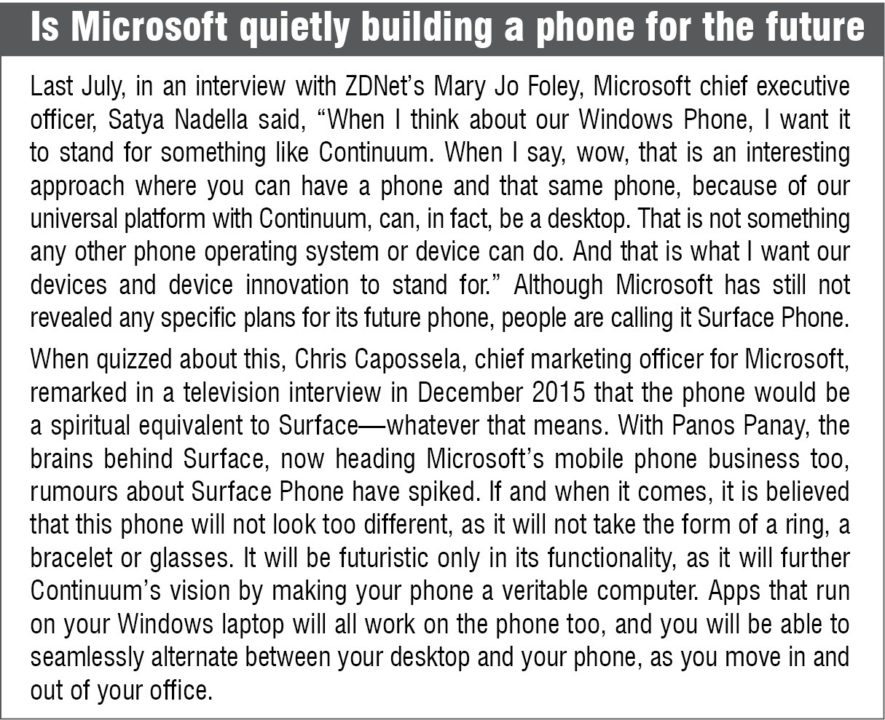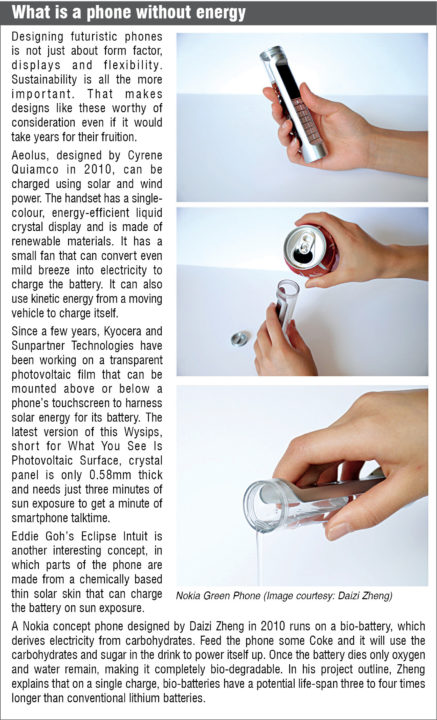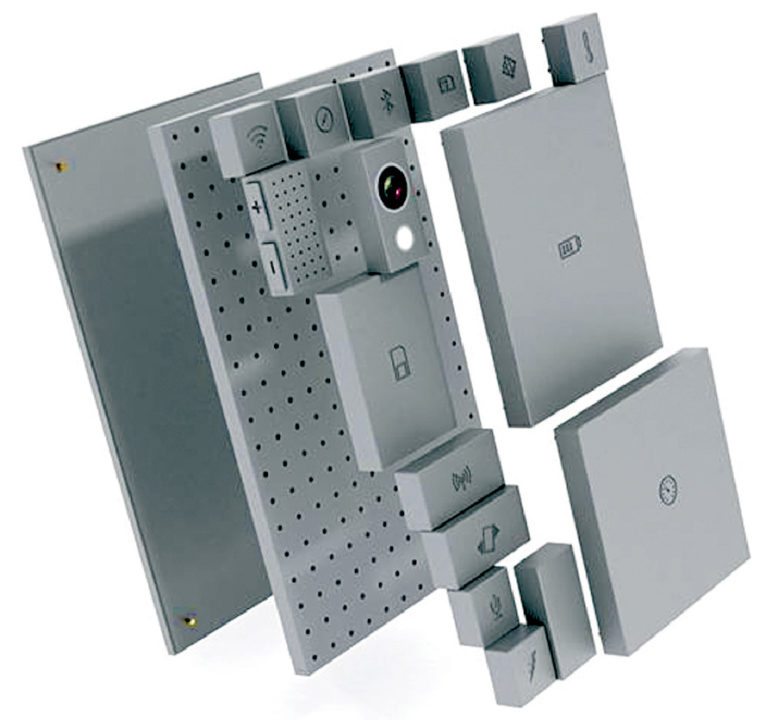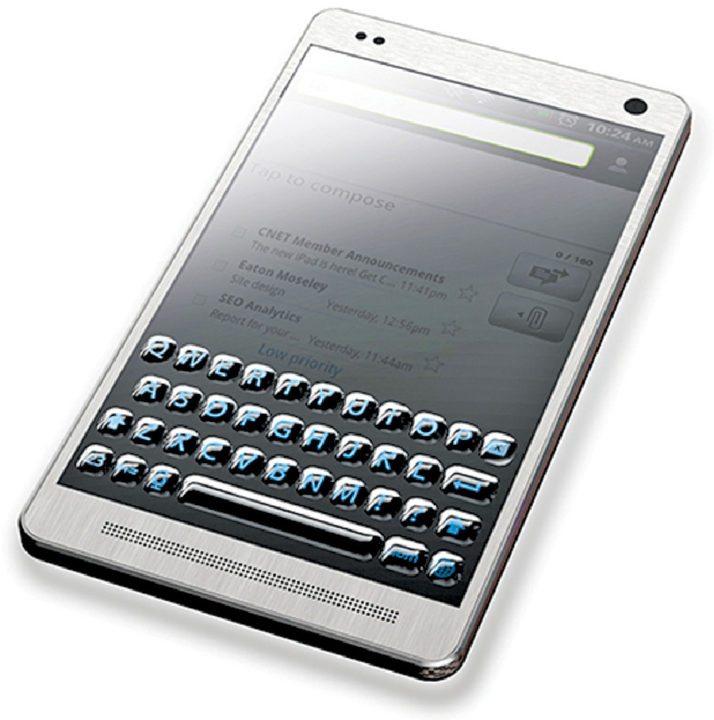As far as technology is concerned, the future is always far away. Designers never live in the present moment. If they did, we would not be having smartphones in our hands. And now that we do, they are busy designing something else—phones that can be folded, phones that can be worn and so on.
We look at some such mind-blowing concept phones. Some are new while others were developed years ago, but continue to fascinate developers and user communities even now.
Although you will want to pre-order many of these fantastic phones as soon as you read about these, you might have to wait because many are still no more than concepts, while others are going through the rigours of development.
Your content, only for your eyes
Phones of the future are expected to be as capable as desktop computers, and might even be used for critical business transactions. So a greater level of security would be needed.
Some years ago, Dell developed a software based technology that overlays a distorted pixel based pattern across the screen. This on-demand security feature n arrows the viewing angle, so that only the user can view the contents of the screen. Those viewing from behind or from the sides cannot. Already available on some Dell laptop models, this would be a nice feature to have on future phones, too.
arrows the viewing angle, so that only the user can view the contents of the screen. Those viewing from behind or from the sides cannot. Already available on some Dell laptop models, this would be a nice feature to have on future phones, too.
A few months ago, NTT DoCoMo and Fujitsu unveiled a phone that can identify the user through iris recognition. This could be used to unlock the phone as well as to certify mobile payments without having to enter passwords in public.
Hanky-panky phones
With the growing popularity of organic light-emitting diodes (OLEDs), a technology that enables displays to be made of flexible, organic materials, the advent of graphene that promises a lot of disruptions in everything from displays  to hardware, and continuous improvements in flexible electronics, we can expect to see phones that can be rolled up like paper or folded up like hankies.
to hardware, and continuous improvements in flexible electronics, we can expect to see phones that can be rolled up like paper or folded up like hankies.
The quest for flexible phones has been on for quite some time now. A few years ago, NEC Design came up with an interesting Tag Soft-Shell mobile phone, made of a rubbery, shape-memorising material, which enabled the phone to flex at the user’s command.
Nokia 888 is another concept that combines a flexible touchscreen with liquid battery to ensure flexibility. A touch-sensitive body cover enables the phone to understand the environment and adjust to it.
Morph, another Nokia concept, relies on nanotechnology to deliver flexible materials, transparent electronics and self-cleaning surfaces.
Fluid Smartphone, designed by Brazilian designer Dinard da Mata for Philips, works like a slap-wrap bracelet that wraps around the wrist.
Samsung has unveiled several ideas using its YOUM flexible OLED displays. So far, LG too has shown off many wonderful flexible concepts like Flutter and Helix bracelet.
Apple, too, has filed patents for flexible devices. So we expect a lot of fun to unfurl in the coming years.
Wear your phone
A logical result of miniaturisation and flexibility are wearable phones—a theme that really excites concept phone designers. LG’s Helix bracelet is a rubber and stainless-steel phone full of flexible electronics and a touchscreen display. When attached to a belt, the magnetic charger taps kinetic energy to charge the battery.

A wearable phone concept designed by Philipp Skorobogatov in 2013 turned out to be a finalist in the recent HTC 2020 design contest. The wearable is basically a fancy bracelet with modular aspects, customisable looks and features. Future versions of this design will have energy-saving screens.
In 2010, Mexican designer Veronica Eugenia Rodriguez Ortiz created Yuxa, an eco-friendly bracelet-like phone concept. The device is made of materials like plant fibres and biodegradable plastic. It has an OLED display, rechargeable battery and an innovative way of communicating with people using vibrations.
Some designs like these continue to entice people years after their creation. However, others go in a poof. Glove One, for example, was a design developed by Bryan Cera in 2012. It was designed like a glove you wear, with components wrapping all your fingers. Too cumbersome!
In 2014, Big Bang Studios released a video showing a futuristic Ring Phone with a holographic projector, wireless charging battery and other nice ideas. However, comments on the video showed that users might not like the idea of a holographic display, which offers no privacy.
See-through phones
Last year, Lenovo-backed Chinese company ZUK showed off a concept phone that had a fully-transparent screen. The phone could perform all the functions of a regular smartphone and display all details on the screen, while still letting users see through it. The concept featured an almost bezel-free frame. However, it would take many more years to make a fully-functional phone of that sort, according to experts, because the battery itself would take up a lot of space.

Fitting the battery and other hardware on a large bezel on the side of the transparent screen would look a little awkward in a small form device like a smartphone. That said, when we get to a stage when phones can be powered through Wi-Fi or other wireless means, then perhaps such a fully-transparent, bezel-free phone would become feasible.
Keyboard on demand
Although mobile devices are getting quite powerful, many people still find it difficult to type long documents using on-screen keyboards.
A technology being developed by Tactus Technology could provide a more comfortable way to type in future phones. The company’s prototype touchscreen can show up a user-friendly QWERTY keyboard on demand. This involves replacing a touchscreen phone’s window or cover lens with a special tactile layer, which works based on the principles of micro-fluidics.
According to the company, “Small fluid channels are routed throughout the tactile layer and enable the fluid to expand the top polymer layer to create physical buttons.” This enables the buttons to bubble up when needed and flatten out when not in use. A controller is used to control the state of these buttons, while an application programming interface allows integrated software/application based control.
Build your own future phone
All of us have a vision of our future phone. How nice it would be if we could build it ourselves? That is what Dave Hakkens’ Phonebloks project aims to achieve. This ongoing project, which started in 2012, aims to make a phone completely modular. It works towards a future where you can just assemble your own phone using building blocks. When you want to upgrade, simply change the blocks you wish to. If you have a great idea, build a new component and add it.
Google is into this great idea, too, with Project Ara. If you could get a basic phone for US$ 50 and turn it into an advanced smartphone by adding all the great stuff you want, the company believes that that could lower the entry barriers in this industry. According to Google, it all starts with an endoskeleton, or endo, the structural frame and data backbone of the device. The user can populate the endo with modules, the building blocks that make up the vast majority of the phone’s functionality and features.
The modules can be easily and safely inserted and removed at any time, even while the device is powered on. The modules also have user-replaceable covers or shells, which provide a creative canvas for users to make their phones look exactly as they wish.
Other modular phone efforts include Xiaomi Magic Cube, PuzzlePhone and FonKraft. If you look at most of these modular phone projects, you will realise that these are not working against each other, but together in many ways—something that the future needs!
Modular phones would not only foster innovation but also reduce a lot of e-waste, helping a sustainable future. These would also do away with the frustration that many of us face when we have just shelled out thousands of rupees to buy a phone, only to realise within a few months that the next generation is already here. If you love the idea of building your own phone, share your efforts and ideas to make these projects a success.
Do you like this article? You may also like: click here
Janani Gopalakrishnan Vikram is a technically-qualified freelance writer, editor and hands-on mom based in Chennai








